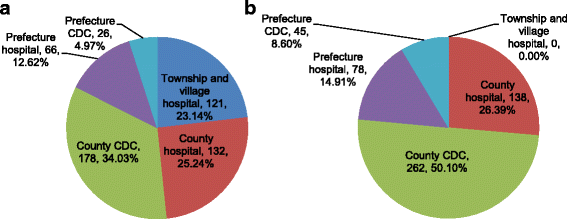The challenge of maintaining microscopist capacity at basic levels for malaria elimination in Jiangsu Province, China
- PMID: 29650008
- PMCID: PMC5898017
- DOI: 10.1186/s12889-018-5307-y
The challenge of maintaining microscopist capacity at basic levels for malaria elimination in Jiangsu Province, China
Abstract
Background: Local malaria transmission has decreased rapidly since the National Malaria Elimination Action Plan was launched in China in 2010. However, imported malaria cases from Africa and Southeast Asia still occur in China due to overseas laborers. Diagnosis by microscopy is the gold standard for malaria and is used in most hospitals in China. However, the current capacity of microscopists to manage malaria cases in hospitals and public health facilities to meet the surveillance needs to eliminate and prevent the reintroduction of malaria is unknown.
Methods: Malaria diagnoses were assessed by comparing the percentage of first visit and confirmed malaria diagnoses at Centers for Disease Control and Prevention (CDCs) and hospitals. The basic personnel information for public health departments and hospitals at different levels was investigated. The skills of microscopists for blood smear preparation and slide interpretation were also examined at the county and township levels.
Results: Inaccurate rate with 13.49% and 7.32%, respectively, in 2013 and 2014, from 341 and 355 reported cases from sub-provincial levels in Jiangsu province. Most of the 523 malaria cases reported in Nantong Prefecture from 2000 to 2014 involved patients who first visited county CDCs seeking treatment, however, none of these cases received confirmed diagnosis of malaria in townships or villages.The staff at county CDCs and hospitals with a higher education background performed better at making and interpreting blood smears than staff from townships.
Conclusions: The network for malaria elimination in an entire province has been well established. However, an insufficient capacity for malaria diagnosis was observed, especially the preparing and reading the blood smears at the township and village levels, which is a challenge to achieving and maintaining malaria elimination.
Keywords: Diagnosis; Malaria elimination; Microscopy.
Conflict of interest statement
Ethics approval and consent to participate
This study was reviewed and approved by the Institutional Ethics Committee of Jiangsu Institute of Parasitic Diseases (JIPD). The written informed consent was obtained from all participants before the interview or evaluation.
Consent for publication
Not applicable.
Competing interests
The authors declare that they have no competing interests.
Publisher’s Note
Springer Nature remains neutral with regard to jurisdictional claims in published maps and institutional affiliations.
Figures




References
-
- Ministry of Health of the People’s Republic of China. National malaria elimination action plan (2010–2020) . http://www.moh.gov.cn/mohbgt/s10788/201005/47529.shtml. Accessed 17 Jun 2016.
-
- Zhang Q, Geng QB, Sun JL, Zhang ZK, Lai SJ, Zhou S, et al. Epidemiological analysis of the deaths of malaria in China, 2005-2014. Zhonghua Yu Fang Yi Xue Za Zhi. 2016;50(4):302–305. - PubMed
MeSH terms
Grants and funding
- BK20141106/Natural Science Foundation of Jiangsu Province/International
- BK20150001/Natural Science Foundation of Jiangsu Province/International
- 0928/Jiangsu Provincial Medical Youth Talent, the Project of Invigorating Health Care through Science, Technology and Education/International
- BE2016631, BM2015024/Jiangsu Provincial Department of Science and Technology/International
- 2016IK146/General Administration Quality Supervision, Inspection and Quarantine of the People's Republic of China/International
LinkOut - more resources
Full Text Sources
Other Literature Sources
Medical

